The tiny French town that changed the course of history
By Chrissie McClatchie
The early hours of March 5, 1815, were tormented ones for Napoleon Bonaparte. He had been back on French soil for four nights, after fleeing incarceration on the island of Elba, off the coast of Tuscany in Italy. His march north towards Paris was gaining momentum. But that day would make or break his ambitions of reaching the capital and reclaiming the throne. For the exiled emperor, everything hinged on the welcome he received in Sisteron. As he awaited the return of the messenger sent ahead of him, sleep, by all accounts, evaded him.
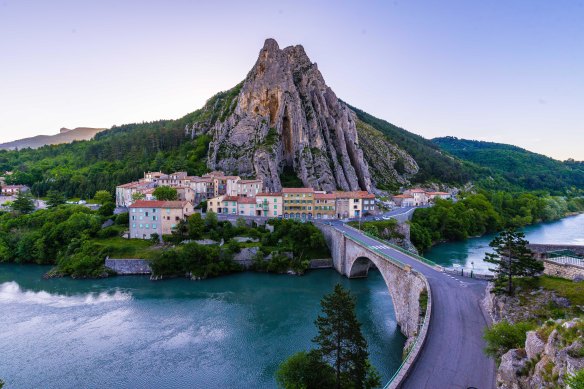
Sisteron and the Durance River. For one day over 200 years ago, this small town — current population about 8000 — held the course of French history in its palm.
Today, most French only know Sisteron, a small provincial town about an hour and a half north-east of Marseille, from driving past its fissured Rocher de la Baume rock formation at speed on the autoroute connecting the Mediterranean coast with Grenoble, the gateway to the French Alps. Or else, because they tuck into tender, slow-roasted Sisteron lamb, the highly-prized local breed, over family meals at Easter. But for one all-important day over 200 years ago, this small town — current population about 8000 — held the course of French history in its palm.
My lesson in this chapter in the Napoleonic era is coming via a recorded narrative that booms out in English across the bastion of Sisteron’s tiered medieval citadel that Henri IV, who ruled France from 1589 to 1610, called the most powerful fortress in his kingdom. I had already gleaned the headline facts about Napoleon’s march inside a small museum at the entrance, but the voices of the audio commentary are bringing the tension of those hours to life.
As he fed wood into the fireplace in the Chateau de Malijai, a noble house 20 kilometres from Sisteron where he sheltered for the evening, Napoleon considered the possible outcomes. Provence was still resolutely royalist, while the Dauphine (a historical alpine region of south-east France) was on his side. Sisteron straddled the border of the two.
If he is permitted to pass, he knows Paris is his. If he isn’t, then time moves forward without the Hundred Days – as the tumultuous period between his arrival in the capital on March 20 and the restoration of Louis XVIII to the throne on July 8 is known – nor defeat at the hands of British and Prussian forces at the Battle of Waterloo (or ABBA’s career-kickstarting Eurovision song).
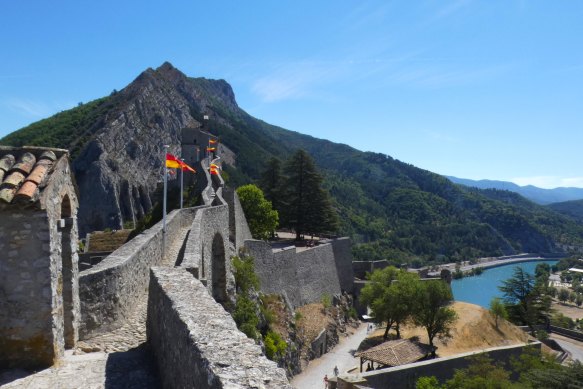
The Citadel above Sisteron
From the towering citadel, built into a rocky outcrop high above the Durance River, the views that sweep through the valley seem endless. Below, the houses of the historic centre huddle close as if in muted, hurried conversation. It’s as if I’ve pressed rewind on time. The atmosphere heavy, I imagine bewildered townsfolk scurrying down andrones, the town’s maze-like covered passageways, to share news and speculation. Would the mayor, a sworn royalist, arrest the usurper as he crossed the Pont de la Baume, the only bridge across the Durance River for miles?
Unlike the historical figures of my imagination, I already know the answer. On the orders of the governor, the citadel had been stripped of all ammunition. Napoleon was assured free passage. Just before lunch, he reached the entrance to the town to be met by the mayor. A crowd gathered outside the local inn where he had a meal. Less than three hours after he arrived, he moved on, the worry of the previous night evaporating as he looked forward to the next stop, Gap.
Given how pivotal a moment this was, I find it fitting that Sisteron is the halfway point on the Route Napoleon, an epic 325-kilometre French road trip that retraces the triumphant path Napoleon carved out from the Cote d’Azur to the French Alps before arriving in Paris on March 20.
The route officially starts in Golfe-Juan, a coastal resort sandwiched between glittery Cannes and the superyacht hub of Antibes. The scattering of fisherman and pottery warehouses that greeted him as he landed on the beach on March 1 has long been replaced by chic beach clubs and yacht broker’s offices, although the ceramic tradition of Golfe-Juan and its inland neighbourhood Vallauris endures. An artist, rather than a politician, happens to be feted as its most famous resident as it was in the town’s ceramic studios that Pablo Picasso honed his clayworking skills.
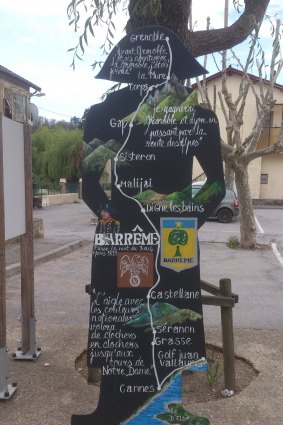
Napoleon’s route
Picasso eventually settled in Mougins, an irresistibly photogenic hilltop village in the hills behind Cannes. Napoleon passed through, too, apparently mistaking the sound of olives crushing under the weight of millstones for gunfire. Recovering from the scare, he pushed on for Grasse, a town whose reputation for perfume was well-established even by the time he marched by.
This first length of the route is classic Cote d’Azur, all sparkling sea, fine dining restaurants and magazine-worthy vistas. Although that’s no complaint – as it also means I’m able to stand surrounded by Picasso’s immersive Guerre et la Paix mural inside a 12th-century chapel at the Musee National Picasso “La Guerre et la Paix” in Vallauris, and take a quick tour of the Fragonard perfumery in Grasse – I do find it hard to grasp the magnitude of Napoleon’s march up to this point.
The sense of adventure really kicks in as the sprawl of Grasse fades into the distance behind me. It’s here the N85, as the Route Napoleon is administratively known, comes into its own. The built-up landscape of the coast gives way to the sparsely habited hinterland and I negotiate the first of many hairpin bends that weave through limestone arches with little more than a low stone wall separating the single-lane road from a dizzying vertical drop.
The mix of tight cliff-face turns, vast, flat stretches across garrigue-scattered plateaus and cinematic alpine scenery has made the road trip a classic motorbike journey in either direction, and I see those with two wheels navigate the turns with much more grace than me in my under-powered Nissan Qashqai.
I know it’s not a competition, but when I meet a pack of gleaming vintage Italian touring cars, I can’t help but feel this is a trip I should be undertaking in a similarly memorable vehicle.
Napoleon’s transport of choice was four-legged and, as an alternative to driving, a Route Napoleon a Cheval (Route Napoleon by horse) is marked out from Grasse to the outskirts of Grenoble. Between Grasse and Sisteron the trail follows the GR406, the Grande Randonnee long-distance walking itinerary that retraces the Emperor’s exact footsteps.
While the tarmac road might not take me past the precise spots where Napoleon hastily hoisted bivouac refuges for the evening (when he wasn’t offered a bed in a noble’s house), it does weave through all his touch points: Castellane, at the edge of the dramatic Gorges du Verdon, Europe’s answer to the Grand Canyon; Barreme, an unassuming village whose sleepiness belies a rich tradition in lavender production and a wealth of ammonites cast for eternity in the dusty terrain; and Digne-les-Bains, the modern-day administrative capital of the Alpes-de-Haute-Provence department.
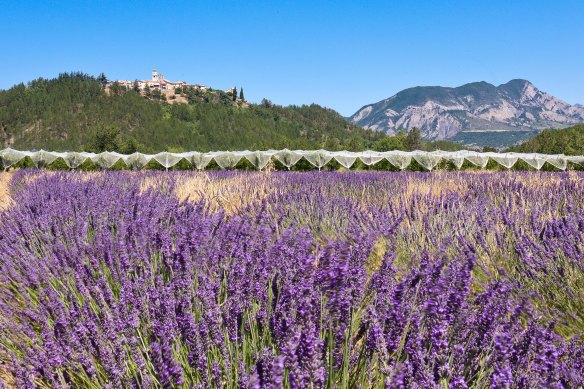
Fields of lavender around Ventavon Village in the Alpes-de-Haute-Provence.
Napoleon only stopped for a couple hours in Digne-les-Bains but the spa town definitely warrants a longer stay. I spend two hours alone at the Maison Alexandra David-Neel, where artefacts such as a Tibetan rosary necklace fashioned out of human bones are fascinating mementoes from the trailblazing travels of Alexandra David-Neel, the pioneering 20th-century French adventurer and feminist who made Digne-les-Bains her home.
The length of the Route Napoleon can easily be covered in one day. But to do so is to barely scratch the surface of this historic trail. From Digne-les-Bains, I push on for 45 minutes more to reach Sisteron. Given its role, the town feels like the logical place to break up the journey. Before I arrive, I take a quick detour past Chateau de Malijai, now the town hall in the village of the same name.
Unlike Napoleon, I don’t struggle to sleep in Sisteron. My eyes shut almost as soon as my head hits the pillow in my stylish boutique hotel room just metres up the cobbled road from where he ate. Earlier in the evening, guided by the Sisteron, Decouverte Virtuelle virtual tour app, I had walked past the inn he visited. In its current guise, it’s an organic grocery store.
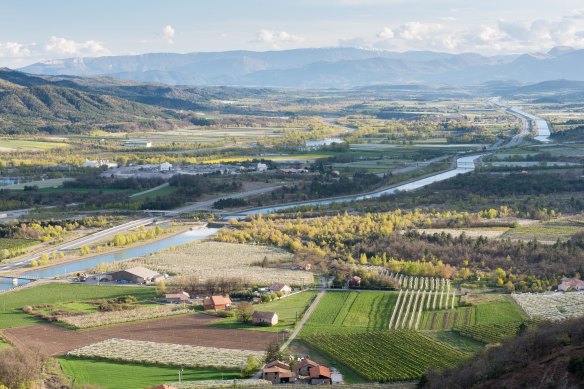
The Durance River and its valley.
I like to think Napoleon would have slept better the following night in Gap, now Provence’s most northerly town, where he received a hero’s welcome on his arrival. Only two days remained between him and Grenoble – that distance converts to 100 kilometres of glorious mountain vistas along gently curving roads that leave the dry plains of Provence well and truly in the past.
Napoleon entered Grenoble on March 7 on the shoulders of its inhabitants. “Until Grenoble, I was an adventurer; in Grenoble, I was a prince,” he would reflect in his political memoirs about the day.
I can’t say that the end of my adventure is feted with such grandeur. But, as I look forward to spending time in the lively city that has sprung up between three imposing mountain ranges (the Belledonne, Chartreuse and Vercors), I realise that another one is about to begin.
The writer travelled as a guest of Provence-Alpes-Cote d’Azur Tourism.
THE DETAILS
Fly
Emirates operates a daily service between Dubai and Nice and can be booked as a connecting flight from Sydney or Melbourne (emirates.com). Pick up a hire car at Nice Cote d’Azur airport. Golfe-Juan, and the start of the Route Napoleon, is a 30-minute drive away (route-napoleon.com).
Stay
In the heart of historic Sisteron, Le Patio de Sophie is a charming three-star boutique hotel in a converted town house with spacious rooms decorated to a rustic-chic theme. Rooms from €135 ($223). See lepatiodesophie-sisteron.com.
Sign up for the Traveller Deals newsletter
Get exclusive travel deals delivered straight to your inbox. Sign up now.